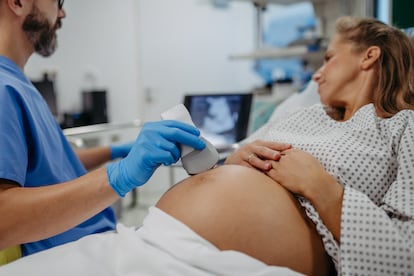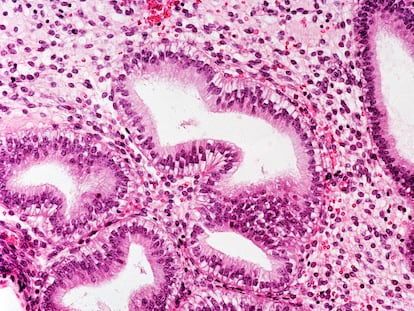The placenta: A biological treasure discarded at birth
This temporary organ that develops alongside the embryo can deliver clues regarding the health of the pregnant woman and her baby

The placenta means humans do not have to lay eggs. That is a huge simplification, but basically the placenta assumes functions that, in the egg, fall to the yolk. Its emergence in nature was such a success that the vast majority of mammals are defined as placentals. But this product of millions of years of evolution is a treasure that is almost always thrown away. Now, the scientific community is keen to take advantage of this precious medical and biological resource.
The placenta is a temporary organ that begins to develop alongside the embryo, shortly after implantation, acting as a connecting interface between the mother and the fetus. The woman’s blood vessels reach it through the endometrium of the uterus while the umbilical cord, which is vital for the embryo, is attached to it. The incredible structure of the placenta allows the transportation of nutrients and waste products between the mother’s blood and that of the fetus, without the two ever mixing.
The placenta also produces both maternal and fetal regulatory hormones. When the baby is born, the placenta is no longer useful. Looking like a bloody pancake, it is expelled and is normally discarded.
“The placenta should not be considered waste,” says perinatal pathologist Mana Parast, a professor at the University of California, San Diego (UCSD). Parast and her colleagues, Drucilla Roberts, from Massachusetts General Hospital and Harvard University, and Omonigho Aisagbonhi, from UCSD, have written an article published in the journal Trends in Molecular Medicine in which they advocate incorporating placental pathologies into clinical practice and research. They argue that the placenta is a hitherto underutilized resource that can “teach us a lot about what went wrong in one pregnancy, as well as providing information on the health of the pregnant person and the baby in subsequent pregnancies,” Parast notes.
An indicator of the mother and baby’s health
According to these experts, the placenta is only usually examined in the event of a stillbirth, but this organ provides clues to other pathologies such as low birth weight and neurological problems in babies, as well as preeclampsia — a syndrome of hypertension — and other cardiovascular conditions in the mother. Defects in the placenta can predict future problematic pregnancies, and a lesion called decidual artery disease indicates cardiovascular risk for the woman. In premature deliveries, when the baby often receives antibiotics, an examination of the placenta could immediately detect a fungal infection so that antifungals could also be administered.
If placental examination were included in clinical trial research, this could reveal new relationships between indicators, diseases and treatment. “Imagine if we could tell a patient with preeclampsia, intrauterine growth retardation or preterm delivery what her chances of recurrence are, based on her individual placental pathology, and perhaps better advise patients on how a particular treatment, for example aspirin, could prevent these complications in a future pregnancy,” Parast says.
In 2015, an international convention in Amsterdam established a standardized protocol for placenta analysis, along with criteria for diagnosing four main types of pathology. But, according to Parast, this still hasn’t properly caught on 10 years later. There are various reasons for this. Besides being a new system that has been applied retrospectively in clinical trials but not yet prospectively, there are few specialty programs and few specialists, she says.
And there is resistance: some medical organizations “do not consider placental examination as part of standard care, perhaps with the exception of stillbirths,” Parast explains. In the US, where medical malpractice lawsuits are common, “many specialists see placental pathology mostly useful as a defense against malpractice claims.”
The forgotten element
According to María de la Calle, head of Medical Obstetrics at Madrid’s Hospital La Paz and associate professor at the Madrid Autonomous University’s School of Medicine, “the placenta used to be the great forgotten element,” in Spain but is becoming less so. De la Calle points out that currently “around 10% of placentas” are sent for pathology, in cases of fetal death, intrauterine growth retardation, monochorionic twins which share the placenta and can present imbalances in blood flow, multiple pregnancies, infections and other complications. The rest of the placentas are incinerated along with other biological waste. However, she stresses that more specialists are needed in view of the growth of this diagnostic field.
The goal is not to examine placentas if there is no reason to do so. According to Parast, “to begin with, we should focus on pregnancies in which there has been a complication; applying placental pathology to all cases is not feasible, even in rich countries.” But even in pregnancies without problems, certain types of stem cells can be extracted from the placenta, while its tissue is used in grafts for healing burns and wounds that are difficult to treat, without the risk of immune rejection. However, placenta donation is not yet common practice.
Nothing prevents the mother from eating her placenta or drinking it in smoothies; it can even be turned into art or jewelry, as numerous websites suggest. But life within the womb is increasingly recognized as a factor in the programming of health and disease in adulthood, and the placenta holds clues to that programming.
Sign up for our weekly newsletter to get more English-language news coverage from EL PAÍS USA Edition
Tu suscripción se está usando en otro dispositivo
¿Quieres añadir otro usuario a tu suscripción?
Si continúas leyendo en este dispositivo, no se podrá leer en el otro.
FlechaTu suscripción se está usando en otro dispositivo y solo puedes acceder a EL PAÍS desde un dispositivo a la vez.
Si quieres compartir tu cuenta, cambia tu suscripción a la modalidad Premium, así podrás añadir otro usuario. Cada uno accederá con su propia cuenta de email, lo que os permitirá personalizar vuestra experiencia en EL PAÍS.
¿Tienes una suscripción de empresa? Accede aquí para contratar más cuentas.
En el caso de no saber quién está usando tu cuenta, te recomendamos cambiar tu contraseña aquí.
Si decides continuar compartiendo tu cuenta, este mensaje se mostrará en tu dispositivo y en el de la otra persona que está usando tu cuenta de forma indefinida, afectando a tu experiencia de lectura. Puedes consultar aquí los términos y condiciones de la suscripción digital.
More information
Archived In
Últimas noticias
Most viewed
- Sinaloa Cartel war is taking its toll on Los Chapitos
- Oona Chaplin: ‘I told James Cameron that I was living in a treehouse and starting a permaculture project with a friend’
- Reinhard Genzel, Nobel laureate in physics: ‘One-minute videos will never give you the truth’
- Why the price of coffee has skyrocketed: from Brazilian plantations to specialty coffee houses
- Silver prices are going crazy: This is what’s fueling the rally










































